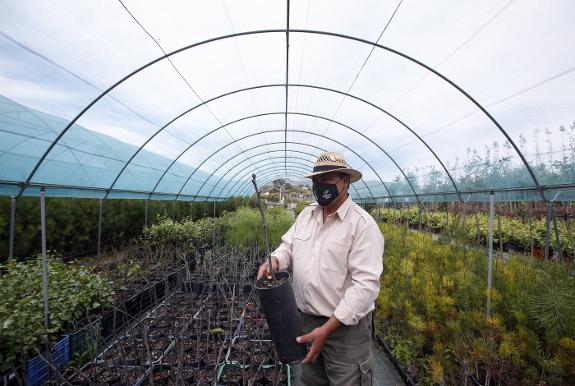The nursery where the Costa's parks are born
Provincial centre. The nursery is run by the Diputación, and it grows 60,000 trees and plants a year for public gardens and for reforestation
IGNACIO LILLO
Viernes, 20 de agosto 2021, 10:12
When he walks through the parks, Alberto Ortega often recognises his work. "That's a tree that I grew," you may hear him say. Alberto is a gardener, one of the team at the provincial nursery, and has been working with plants for 30 years. "You take a Grevillea seed, which is delicate like a cigarette paper, you plant it, you bring it up step by step and in two years you see that it is four metres tall... it's very satisfying," he says.
The vegetation in the parks and gardens of towns and villages in Malaga start life on the Camino de la Isla, by the river between Vélez-Malaga and Benamocarra, in a nursery which is run by the provincial government, the Diputación. We are given a guided tour by José Manuel Pardo, an agricultural engineer who has been managing the nursery for 20 years, accompanied by the Diputación's Environmental delegate, Cristóbal Ortega, and some of the technicians.
José Manuel, Alberto and Inmaculada Lobato are the heart and soul of this large-scale centre, which produces around 60,000 plants a year and is involved in many different lines of work, including the Malaga Viva programme, which aims to reforest the province with one million trees, and has planted about 400,000 so far.
The councils of small villages come here during the year for the plants and trees they need for replanting or to create new parks or gardens in their municipalities.
Larger trees are also used for the Diputación's reforestation programmes, especially native species which are several years old. They are also used in projects in which local people and NGOs participate, for reforestation in municipalities with fewer than 20,000 inhabitants where the land is marginal, deforested or steeply sloping. For this reason they work with Mediterranean plants and also autochthonous species which have a strong presence in the province. "We try to encourage the use of species which are most resistant to drought and pests," explains José Manuel.
The shrub department
One line of research being carried out at this nursery is an experiment whereby they use different types of technological containers, to obtain plants with the most suitable root structure for successful planting.
The shrub department has an extensive range of species, from Mediterranean areas and elsewhere. These are grown in two ways: on trellises, with the plant tied up and with drip irrigation, and on flooded platforms, which are used for aromatic and flowering plants. These are most in demand in May and June, when councils want them for local festivals and religious processions.
The most common aromatic shrubs are thyme, rosemary, lavender and sage, while the flowering plants are mainly geraniums but also Hibiscus, jasmine, Ficus, Euonymus, Callistemon and mastics.
The nursery is also working on adapting local species such as Arbutus, laurels, Viburnum, Tamarix and Pistacia, as well as almonds, wild olive and pomegranate trees.
"We have a lot of varieties for replacing and improving parks and gardens in Malaga city, but we try to make it increasingly sustainable with plants that can survive with low maintenance, and for that to be successful we need them to adapt very well," says José Manuel.
Watering and fertilising are managed by automated equipment, and the ground is covered with geotextile netting to prevent weeds. It takes around 30 cubic metres of water from La Viñuela reservoir to irrigate these two hectares of ground. In winter the irrigation is not as frequent, but in the summer months it is needed every other day.
Tree nursery
The second part of our visit is to an area called Cela, which is very close to where we have just been, and it borders Benamocarra. This consists of two parts: the covered areas were installed after the big fire at Barranco Blanco in 2012, when the provincial government promised to help the affected villages with reforestation. Now they are used to grow shrubs.
The team here are using an unusual type of plant container called air-pots, which improve the aeration of the roots and helps to transplant them more successfully. They are also testing cuttings taken from riverside trees such as figs, weeping willows, quince from the Genal, tamarisks, ash, pomegranate and white poplars.
"We take cuttings, keep them in water for three days and then put them in the ground," says Cristóbal Ortega. Many of them are already sprouting.
On the adjoining production site are about 5,000 large trees, which have been growing for a period between 18 months and three years. These are cultivated directly in the field, in containers. This is where the carob trees around the Caminito del Rey have come from, to give an example.
The team here also works with poplars, cork oaks, cypresses, holm oaks, three species of pines (Aleppo, stone and resin pines), Grevilleas, orange trees... there are 50 species altogether, and they are fed with horse manure.
"We only concentrate on a few types of tree here, but we grow large quantities of those which are most in demand," says José Manuel. Finally, this provincial nursery also rescues olive trees which have been discarded from the countryside and can be used in gardens for decoration.
"We want to teach local councillors that well-managed native species are interesting for gardens," he says, referring to the fundamental principles of Solutions based on Nature. "Having plants in parks and gardens which grow naturally here is just as interesting as more exotic varieties."
